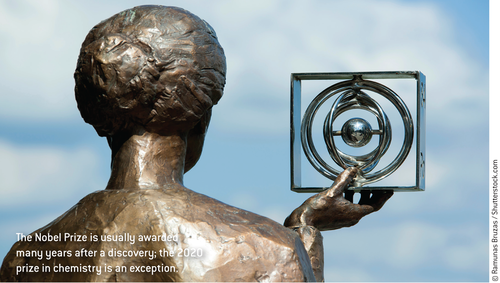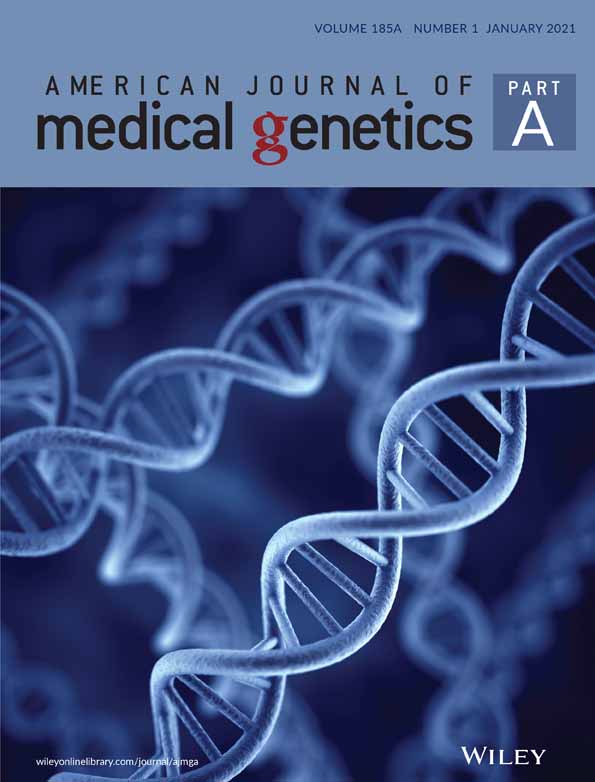Crispr Developers Win 2020 Nobel Prize for Chemistry
This year marks the first time that 2 women have shared the prestigious award
The phone call came at 3 a.m. and woke her out of a deep sleep. Jennifer Doudna, PhD, Li Ka Shing Chancellor's Chair in Biomedical and Health Sciences and a Howard Hughes Medical Institute investigator at the University of California, Berkeley, recognized the caller. It was a reporter from Nature, phoning to get her comments on the just-announced Nobel Prize awards. Dr. Doudna assumed that the journalist wanted input on whomever had won the prize for chemistry. Then the reporter broke the news: Dr. Doudna, along with Emmanuelle Charpentier, PhD, Scientific and Managing Director of the newly established Max Planck Unit for the Science of Pathogens in Berlin, Germany, had jointly received the 2020 Nobel Prize in Chemistry for their pioneering role in the development of clustered regularly interspaced short palindromic repeats (CRISPR) technology.
“I had gone to bed not thinking about it at all, so it was a total surprise,” Dr. Doudna says. “I never once felt favored to win and, in fact, if you had asked me beforehand, I would have said that it would probably be some time before CRISPR genome editing would be considered—perhaps after it had become the standard of care for multiple genetic diseases.” Thrilled to receive the honor, she notes that she was “very proud that it went to 2 women for the first time—but definitely not the last time.“
A simple yet powerful tool for editing genomes, CRISPR/CRISPR-associated (Cas) technology allows researchers to easily alter DNA sequences and modify gene function. In their 2012 paper, a research team including Drs. Doudna and Charpentier showed that CRISPR could edit DNA in an in vitro system (Jinek et al, 2012). The discovery was quickly expanded upon by other researchers, and CRISPR was rapidly adopted by labs across the globe. CRISPR provides an array of potential applications in medicine, such as the correction of genetic changes that cause certain human conditions, as well as other ways to treat and prevent disease. It can even be applied in agriculture to manage crops. The ability to engineer genomic DNA in cells and organisms in such a precise fashion has major implications for basic biology research, medicine, and biotechnology.
A Winning Collaboration
A structural biologist, Dr. Doudna earned a biochemistry doctorate under the supervision of Jack Szostak, a geneticist who would go on to win a Nobel Prize in 2009 for helping to determine how telomeres and the enzyme telomerase protect the chromosome ends. She pursued a postgraduate fellowship in the University of Colorado in Boulder laboratory of Thomas Cech, who had just won the 1989 Nobel Prize for discovering the catalytic properties of RNA. Dr. Doudna worked for several years at Yale University in New Haven, Connecticut, before arriving in Berkeley in 2002.
A French microbiologist, geneticist, and biochemist, Dr. Charpentier was educated in France and pursued academic research in both Europe (Paris, Vienna, Austria, Umeå, Sweden, and Braunschweig, Germany) and the U.S. (New York City and Memphis, Tennessee). Most of her scientific career has been geared toward understanding the fundamental mechanisms of diseases with a particular focus on infections caused by Gram-positive bacterial pathogens such as Listeria, staphylococci, and streptococci.
Drs. Doudna and Charpentier met for the first time at a 2011 microbiology conference in Puerto Rico, where they agreed to collaborate on studying the mechanism of Cas9, the DNA-cutting nuclease at the heart of one of the model CRISPR bacterial immune systems. Working together with Martin Jínek, PhD, a Czech postdoctoral fellow in Doudna's lab, and Krzysztof Chylinski, a Polish grad student in Charpentier's group, their research culminated in the 2012 paper.
Often, researchers are not acknowledged until many years or even decades after their discovery. In this case, however, there was a relatively short lag time, comments Gwenn A. Garden, MD, PhD, Chair in the Department of Neurology at the University of North Carolina School of Medicine in Chapel Hill. “With biology, there usually has to be a lot of validation, which may account for the gap in time,” she says. “The work tends to gain more importance with time.”
Dr. Garden believes that the reason it happened so fast this time is that CRISPR is a tool. “It changed what we are doing so dramatically and rapidly,” she explains. “Recognition came quickly because so many people can use it and are using it.”
Moving Forward
“[CRISPR] changed what we are doing so dramatically and rapidly. Recognition came quickly because so many people can use it and are using it.”
– Gwenn A. Garden, MD, PhD
The area of gene therapy and gene editing in general continues to raise questions, especially with regard to germline engineering and potential unintended consequences. “It is definitely controversial, and understandably so,” says Dr. Doudna. “I have been encouraged by how quickly the discussion on this topic has evolved, and how seriously it is being taken by countries around the world.” She feels strongly that international guidelines should be established now, while the technology is still some distance from being fully realized. “It's also important to show how much can be done without resorting to germline editing,” she adds. Dr. Garden points out that human germline editing is “still far from where we are today using CRISPR because it doesn't have 100% fidelity and you have to be careful how to use the currently available tools. I don't know how far away we are from developing tools that only target the gene of interest. I'm sure those will be developed, and then we will have another set of controversies.”
The field of CRISPR-Cas biology and engineering continues to develop at a dizzying speed, with new developments emerging almost weekly. One important clinical application will be for infectious diseases. “The COVID-19 pandemic has made it clear to everyone that we are underprepared when it comes to diagnostics of infectious diseases, and we are already starting to see rapid CRISPR-based diagnostic tests emerging, with more on their way,” says Dr. Doudna. “The fact that these tests can be quickly retooled to detect different pathogens, and that they can be used at the point of need without requiring a laboratory, makes me optimistic that we will be seeing a rapid shift in clinical diagnostics in the very near term.”





